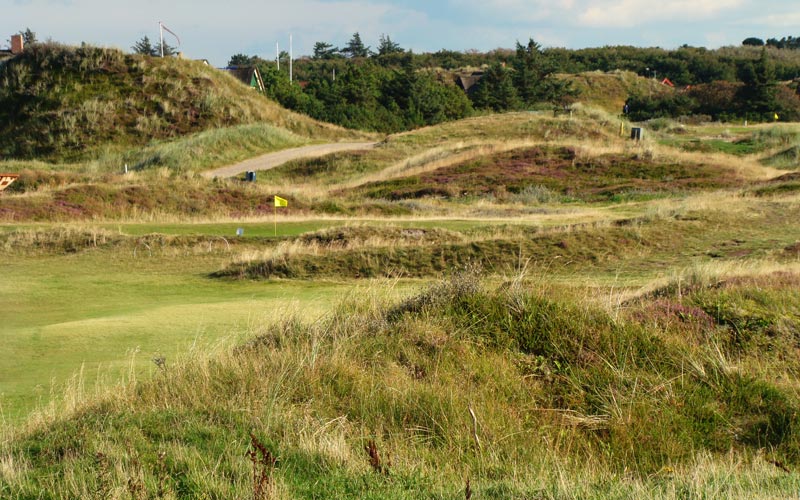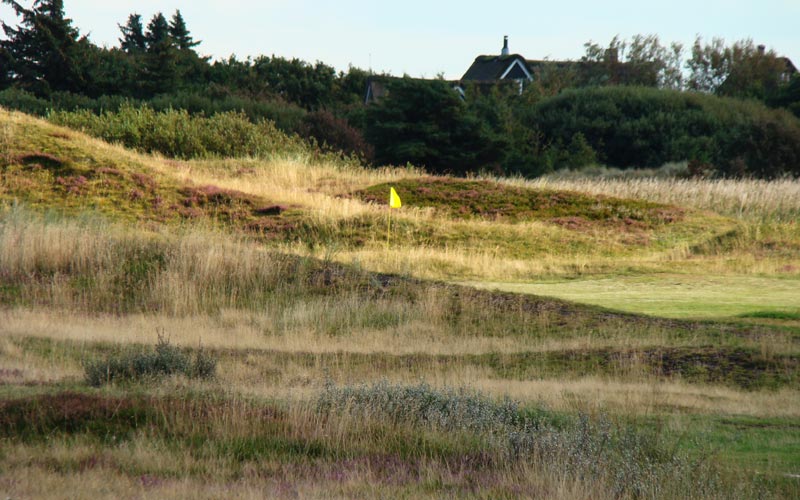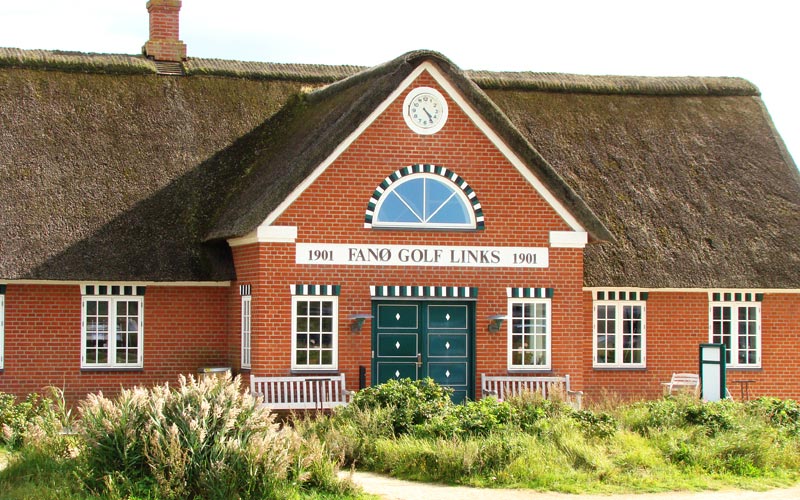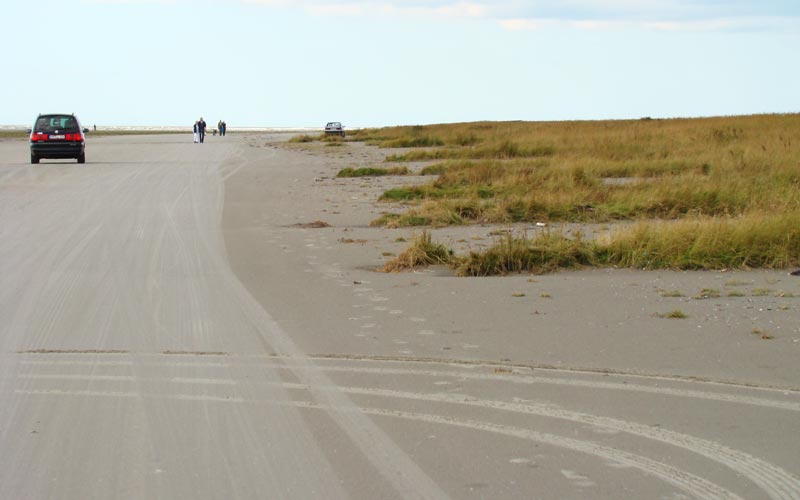Fano Golf Links,
Fano, Denmark
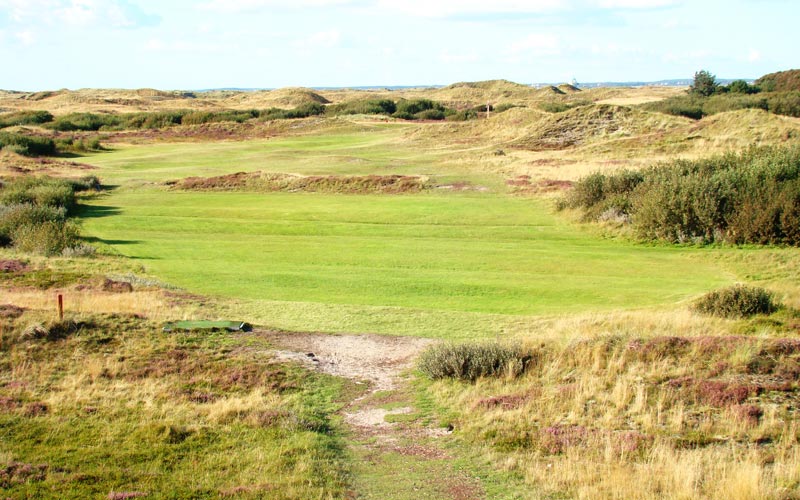
As seen from the exhilarating ninth tee, the prospect of a game at Fano will quicken the pulse of any fan of links golf. The wooden marker in the distance denotes the hidden green’s location.
What to make of Fano Golf Links?
Located on Fano, an island just off the west coast of Denmark, its lack of length (under 5,600 yards from the back), lack of bunkers (there are none) and the fact that the square tee areas are four feet by four feet slabs of artificial turf might lead one to quickly discount it and relegate the course to a certain, lowly level. What a mistake that would be!
Laid across some of the most intoxicating dunescape found in world golf, Fano Golf Links possesses more enticing holes (e.g. the fifth, eighth, ninth, fifteenth, and seventeenth) than most courses that the PGA golfers play week in, week out. With dunes ranging in size from five to twenty-five feet and then crumpled land everywhere else, it is ideally suited for golf. Add in how the heather and lyme grasses thrive in the low humidity on the sandy, treeless landscape and as seen below, literally no matter which way the golfer turn, the course offers one compelling view after another.
As noted with the flags above, a fresh breeze off the North Sea generally livens the proceedings as well. Given how its mix of shortish par fours seems to invariably find a way to rub past some of the interior marshlands that dot the property, prudence off the tee in the form of a long iron, hybrid or even five iron is sometimes the best play. The cumulative result of all eighteen holes is fascinating: The golfer is virtually guaranteed to hit every club in his bag. Driver and three wood will each likely be used on several occasions but it is the mix of long irons/hybrids (either off the tee or as approach shots) that the golfer finds himself frequently hitting that makes Fano Golf Links a thorough test from tee to green , something that few if any other 5,600 yard courses can claim.
The course has evolved greatly since opening as a nine hole course in 1901 (yes, that’s right, it opened a couple of years before Walton Heath, for instance). The gutta percha ball was still in play when Robert Dunlop came to these shores and built Fano Golf Links for a German wine merchant from Bremen. Christoph Meister, noted German golf historian, has gathered the following information about Robert Dunlop from Bill Hewitson in Northern Ireland, who is Robert Dunlop‘s great nephew. In a letter, Bill Hewitson wrote to Douglas Seaton, the North Berwick Golf Historian, in 2008:
The course was originally designed and built by my great uncle, Robert Dunlop. After construction, the first Danish Open was played on 10th August, 1901, probably over 18 holes as it appears to have been a one-day event. It was won by Robert himself, but I would imagine that it was more of an inaugural demonstration than anything else. As your article explains Fano Golf Links was Denmark‘s first golf course, and the location was selected due to the links-type grass on the island. Similar to the North Berwick professionals, he was employed at Prestwick with the same type of daily tasks in club-making, teaching, and course design. My grandmother, Isabella Dunlop, was born in 1875, and Robert, her brother, was slightly younger, so at the time of his work at Fano Golf Links he was only about 25 years old. (CM: Robert was actually born August 30th, 1877) Like the North Berwick men, he headed for the USA, and was employed either in the New York or Chicago areas, but we are not sure in which year he emigrated. Like many of these young men he had an untimely death, during a Hogmanay celebration at his club he fell into an iced-over lake, which re-froze. Being a holiday period he was not missed for some time, being eventually discovered. We never knew the full details.
Hence, one of the reasons that Robert Dunlop is such an elusive figure is that he died in 1907 at the age of thirty years old. Here is a sad cutting from a New York newspaper entitled ‘Scotchman employed near Van Cortlandt Park died in the lake’:
The cronies who are in Winter quarters at O’Connell’s Hotel, near Van Cortlandt Park, have not yet determined how Robert Dunlop died. His body was found yesterday in the water at the north end of the lake in the park, where the ice had broken. He had been missing seven weeks, and the Coroner of Kingsbridge says he believes that the body was in the lake all of that time. Robert Dunlop came to this country from Scotland last Spring. Hardly more than 30 years old, he was unusually gloomy. He left the city and asked for employment on the Van Cortlandt Park links. He was a skillful golfer, and was immediately appointed an assistant. When Winter, the unprofitable season, came, Robert Dunlop sat around O’Connell’s and sulked. Then he began to drink heavily. Finally, he asked for work, and did odd jobs here and there, but he seemed to be able to do nothing but wield a golf stick. At last the O’Connells took him in for the Winter. It was said last night that two inquiries for Robert Dunlop had been made from Scotland. A woman in O’Connell’s said that Robert Dunlop never talked about his people and never told any one that he wanted to end his life.
Indeed, Alex Finlay was so moved by his death that he coordinated for the Eastern Professional Golfers’ Association to pay for Robert Dunlop‘s funeral. What other golf course architecture work Robert Dunlop did is unclear but one of the world’s great holes (today’s fifth at Fano Golf Links) still exists as a tribute.
As the Haskell ball took hold, the 220 to 260 yard par fours that Robert Dunlop built became less relevant. In 1930, according to information unearthed by Meister and confirmed elsewhere, Fano Golf Links was expanded to eighteen holes by Danish engineer Nonboe from nearby Esbjerg. As seen below, approximately two-thirds of the playing corridors of today owe their origins to Nonboe’s work. Yet, more changes were to come with the most substantial ones taking place in the club’s centenary year of 2001. Owned by the Lassen family for all but its initial two years, the then Club Manager Lassen oversaw combining four of Nonboe’s holes into two and the creation of five new holes (today’s seventh through eleventh holes which were built into a nature reserve).
Nonetheless, as assisted by Robert Dunlop to Nonboe to Lassen, the course’s elemental qualities are what resonate with golfers. Many people think that Fano Golf Links provides a great window into how the game was originally played but that is not accurate given all the changes. Credit Nonboe and Lassen for their sensitive work in the dunes and imaginative green placements for allowing Fano Golf Links to exude the old world charm that we find below.
Holes to Note
Fifth hole, 180 yards; Laid out by Robert Dunlop in 1901, the question is whether he had ever seen the Dell hole at Lahinch? If he had, he was obviously quite taken by it as copying is the sincerest form of flattery. If he hadn’t and Duncan devised this blind par three hole on his own accord, then we are talking about a one of the bolder thinkers of golf course architecture at the turn of the 20th century. Either way, the allure of the hole – of lashing out to a blind green at the base of several sand dunes – is as fun today as it was over a century ago and the fact that it is the sole original hole from 1901 indicates that time has done nothing to diminish its playing virtues. Be it in Scotland or the Netherlands, it is holes like this at Fano Golf Links that make the golfer think of the game’s origins whereby sailors and merchants traveling the North Sea 200 plus years ago would chase a ball with a stick up and over dunes.
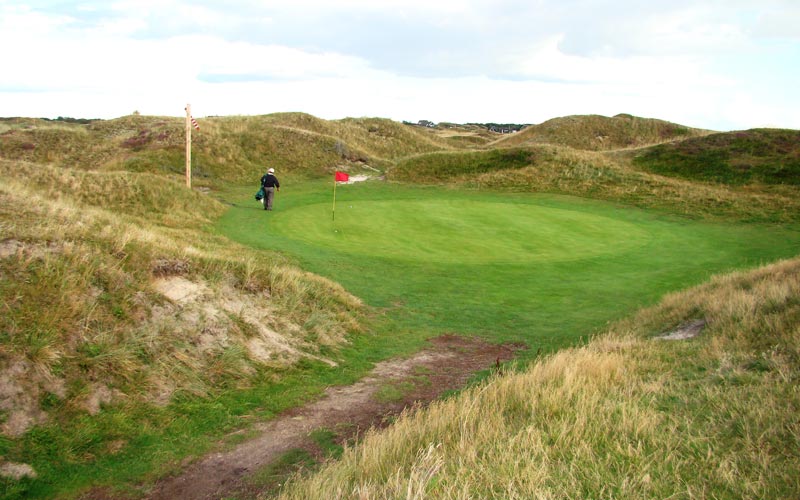
As seen from a top the dune that blocks the view of the green from the tee, the tiny fifth green is surrounded on all sides by dunes. This is the first of four directional markers found behind greens, a testimony to Fano’s rollicking landscape.
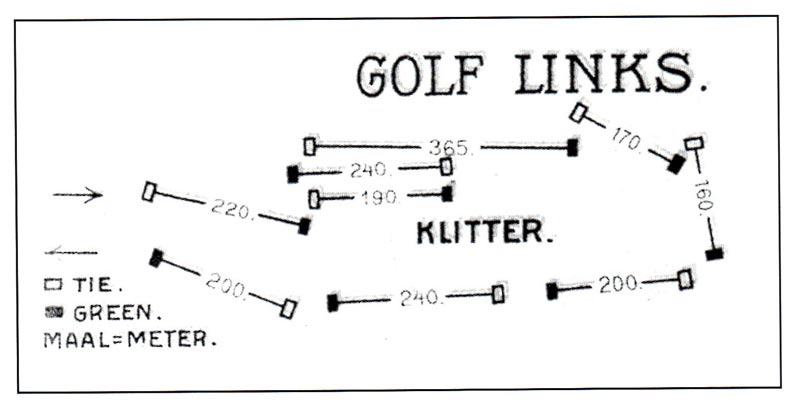
As provided by Meister from a 1919 postcard, here is diagram that shows Dunlop’s original nine hole routing. The sixth is today’s fifth and note how it measured 176 yards back in the days of hickory golf. Dunlop was indeed a very good player!
Eighth hole, 440 yards; Rated the number one handicap hole for good reason, one hardly expects to come across such a brute on a course of this modest length. Both the drive and approach require forced carries and it represents uncompromising, high demand architecture at its natural best. This stretch from the seventh through the eleventh was added in 2001 yet the holes seamlessly tie in with the spirited character of the rest of the course. Full congratulations are due to Lassen and his ancestors would be proud as to how the course has evolved since the family took ownership in 1903. Is it beginner’s luck that a novice of golf course architecture got so much right? Or is it more a function that Lassen was able to slowly tease the best out of the land that he knows and cares for so dearly? The author thinks the latter, providing a powerful lesson to golf course architects: Get to know and appreciate the land before ever disturbing it.
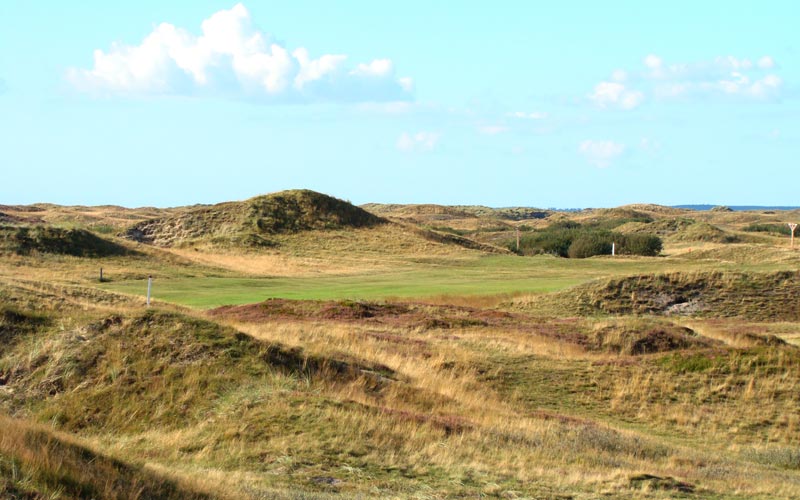
Like a quick punch in the face, the demands off the tee and on the approach at the eighth takes the golfer aback who thought Fano would be an easy ‘holiday’ course. As seen from the tee, the golfer must be wary of the marshland to the right beyond the first dune. The green’s far directional marker at the right edge of the photograph shows how much distance the golfer is expected to cover in just two blows.
Ninth hole, 290 yards; Climbing up to the highest tee on the course, the golfer is rewarded with sweeping views of the dunescape in all directions. Surely this must be one of the most enchanting places in world golf? In an ironic twist, and by no means as a way of condoning it for use at other clubs, the use of mats at Fano Golf Links and their relative small size does afford the opportunity for some outrageously great tee placements, all the while disturbing the tops of dunes in the least manner possible. Down below, the green fairway stands out in fine contrast to the heather and other vegetation on the dunesland that frames the fairway. Lassen did a fine job in preserving the natural crumpled qualities of the land when he built this fairway in 2001.

Though the course doesn’t have bunkers, which isn’t to say that there are no central features with which the golfer must contend. Here at the ninth, a diagonal mound covered in heather 200 yards from the tee is problematic.
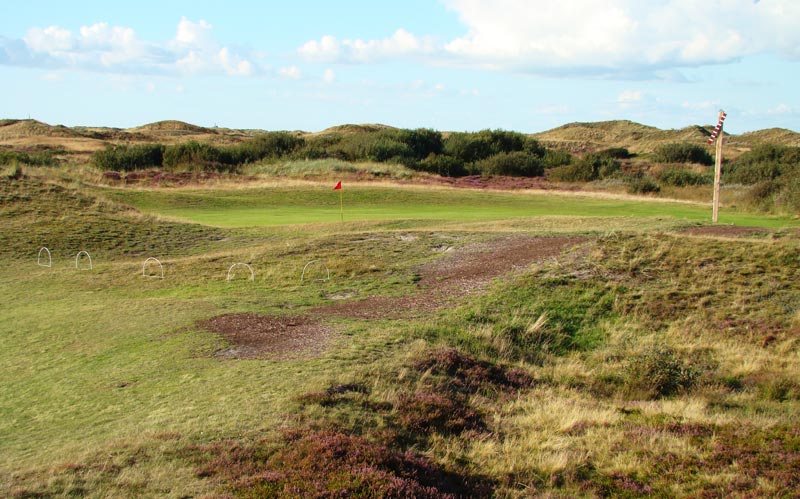
Getting the pitch just right to the partially hidden ninth green is no mean feat. By tucking the green into its own little bowl, Lassen lent the ninth properties that make it feel like Dunlop himself could have built it one hundred years before.
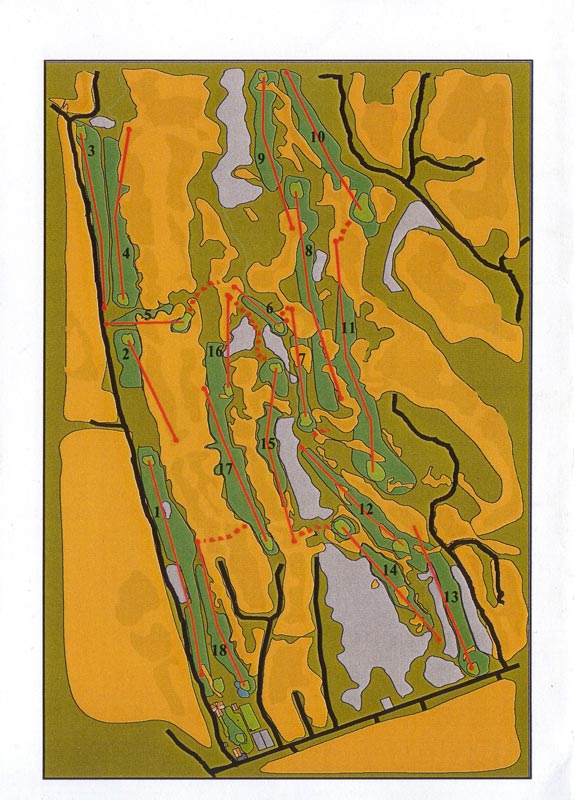
The course received a big boost forward when Lassen was able to build holes on the land that nine and ten now sit softly upon.
Eleventh hole, 500 yards; The first at Fano is a stout 550 yard three shotter that was formed when Lassen combined Nonboe’s first and second holes. On the return nine, here is the course’s other three shotter with its fairway pleasantly weaving low through the dunes, very much in the manner of how many fairways are routed at Royal Birkdale in England. However, the golfer may appreciate this one more because of the manner in which the other fairways go up and over dunes at Fano. Essentially, it’s the variety of ways that the holes interact with nature that makes Fano both special and challenging.

The serene valley that the eleventh fairway zigzags through is in fine contrast to some of the other holes at Fano.
Thirteenth hole, 280 yards; Fano has ten par fours that measure under 350 yards in length which is where it loses distance relative to other par 70 courses. One’s esteem of the course is shaped largely by these holes as they in fact represent more than half of the course. Take the challenge posed here at the thirteenth. Unlike many of the other holes, the golfer has a clear view of the green with the trouble in plain sight. Recently, two golfers played it in opposite manners. One took driver off the tee, trying to reach the green. The tee shot sailed slightly right on the wind and the golfer had to scramble out of the wetland just to salvage a hard fought par. The other player hit five iron off the tee and then a full wedge close to the hole. Though the putt didn’t drop, both players liked how they respectively played it. If such a chess match is appealing , then the player will no doubt join the many who have gone before in holding Fano in high regard.

What is the best play from the elevated thirteenth tee, given how wetlands crowd in on both the left and right sides of the fairway? Certainly the day’s wind factors into the answer.
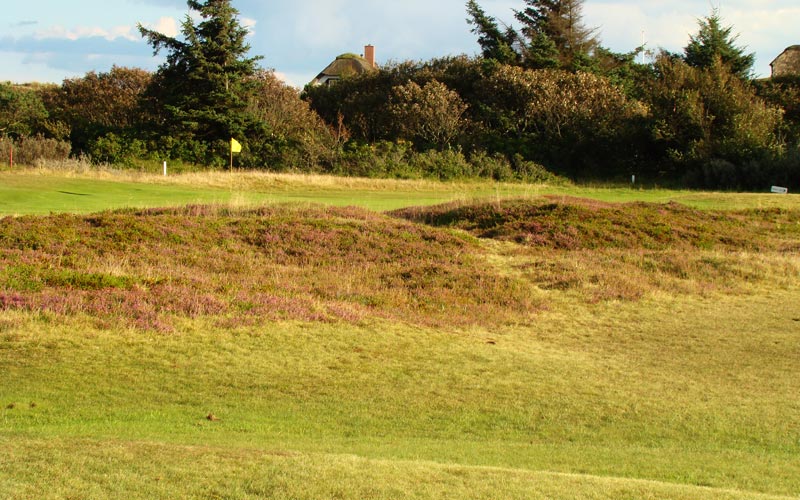
Heather covered mounds diagonally run in front of the thirteenth green. Ala Royal Ashdown Forest, who needs bunkers when there are so many other attractive hazards?!
Fifteenth hole, 410 yards; Like the eighth, this is a hole of unrelenting difficulty with a high ridge seventy yards short of the green turning it into an Alps hole. While it may not be strategic in the sense that there isn’t a safe way around the ridge or a way to gain sight of the flag from anywhere on the fairway, the hole’s key feature (i.e. the ridge) acts as a do-or-die central hazard, forcing the need to find the fairway off the tee if the average club golfer is to entertain hope of scaling the ridge with his second and getting near the green in two. The golfer keeps expecting the course to stumble yet Dane Nonboe’s stretch from thirteen to fifteen is as good as any three hole sequence on the course. According to research provided by Meister, Nonboe was paid with life insurance for his work as money was in short supply in 1930 – what a bargain the club got!
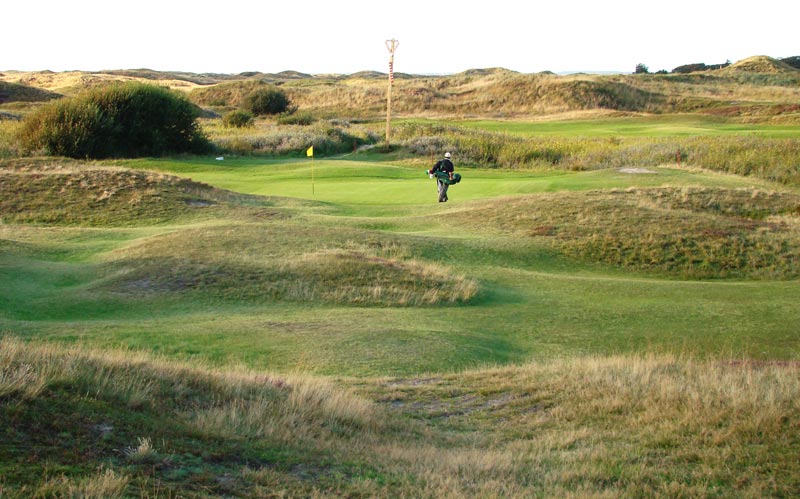
Launched over a tall dune, the golfer’s approach shot must carry all this broken ground to reach the green.
Seventeenth hole, 350 yards; Played as the eighth in 1930, this exemplary teaser was the handiwork of Nonboe, who must be commended for incorporating another classic architectural feature into a hole. In this case, a hog’s back fairway is the standout feature. A good drive hits on it and is thrown left, giving the golfer a clean look down a long narrow green wedged between two dunes. The golfer whose tee ball is kicked away to the right is still in the fairway but his approach into the thirteen yard wide (!) green is from a materially worse angle.

What smart thinking to incorporate this hogback feature into the seventeenth fairway. As is evident above, the golfer very much wants his tee ball to land on or left of the hog’s back as …
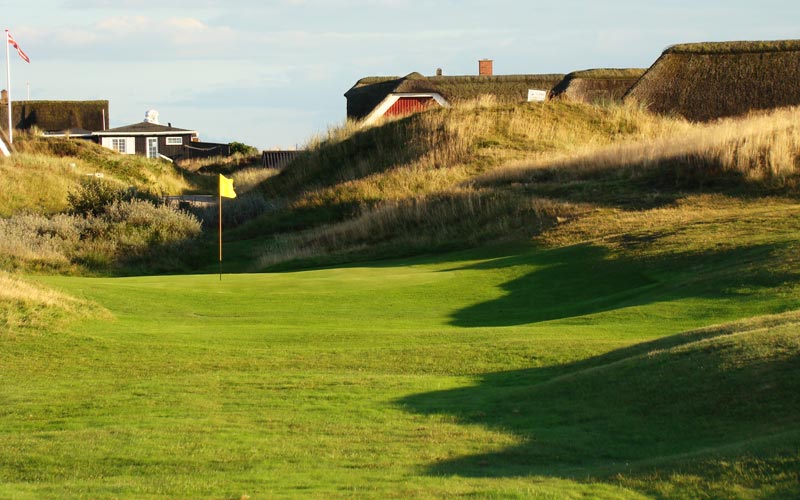
…the pitch is much easier and straightforward than one from the right. Credit belongs to Dunlop for this green location.
Who likes what in golf courses is a personal matter. Those who place importance on the setting and of re-establishing a strong connection with nature will obviously adore Fano. Even the most seasoned campaigner might find himself scampering up and down the dunes like a kid, hopeful to find his ball lying in an advantageous position but always wide-eyed with amazement as to his surrounds. Fano is simply great fun and golf is surely still about fun, yes?
Of course, others place priority in a course’s ability to test the best, which requires a course to possess a certain amount of brute length as well as greens that reward a deft touch around them. Such people might not readily embrace Fano as one of the few must-play courses in Scandinavia – though they might be surprised to learn that Fano hosted the first European national open! Alas, it is fair to say that Fano’s weakness lies in and around the greens. With greens averaging little more than 2,000 square feet and with the green speed commensurate with greens that aren’t mowed every day, the golfer won’t find his interest held at the same high level as the long game. Also, the little recovery shots posed around the greens are often more straightforward than the shots asked of the golfer to get to the green itself.
In the end, so what? The land movement, vegetation, and soil might place Fano among the top two dozen or so raw sites in world golf. Throw in how the holes play around and over the dunes and how other fairways play through the valleys and the golfer is constantly given something to accomplish. Some of the blind tee shots like at the fourteenth are over the tallest dunes on the property and some of the blind approach shots like at the eighth and fifteenth are uncompromising in nature as they play over long patches of broken ground. There is an in-your-face challenge posed at Fano that is distinctly old-fashioned and all the better for it. The golf has not been dumbed down to cater to all tastes and playing levels. Hence, there is a sense of adventure that very few courses obtain.
While on the island, if you feel like treating yourself, by all means stay or at least have a meal at Sonderho Kro (www.sonderhokro.dk). Located at the southern tip of the island, cottages fan out from the main thatch covered building. Dating back to 1722, this fourteen room establishment evokes a period of time far removed from today’s clamor.

The cottages at Sonderho Kro won’t disappoint – just remember to duck when walking through some of their five foot tall doorways!
The End


